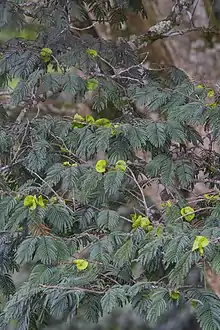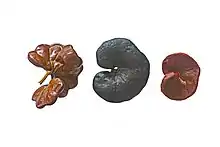| Robrichia schomburgkii | |
|---|---|
 | |
| Enterolobium schomburgkii, unripe pods and foliage of a wild tree in Puerto López, Meta), Colombia | |
| Scientific classification | |
| Kingdom: | Plantae |
| Clade: | Tracheophytes |
| Clade: | Angiosperms |
| Clade: | Eudicots |
| Clade: | Rosids |
| Order: | Fabales |
| Family: | Fabaceae |
| Subfamily: | Caesalpinioideae |
| Clade: | Mimosoid clade |
| Genus: | Robrichia |
| Species: | R. schomburgkii |
| Binomial name | |
| Robrichia schomburgkii (Benth.) A.R.M.Luz & E.R.Souza (2022) | |
| Synonyms[1] | |
| |

Comparison of the fruits of three sympatric species of Enterolobium. E. schomburgkii is the one to the right.
Robrichia schomburgkii is a species of flowering tree in the family Fabaceae.
Names
Robrichia schomburgkii is also known as "dormidero", because of its minute leaflets reminiscent of Mimosa pudica. Mimosa pudica also called by a similar name ("dormidera").
Distribution
Robrichia schomburgkii ranges from Central America to the Amazon basin and even further south.[2]
Description
Robrichia schomburgkii differs from the similar, sympatric, Enterolobium cyclocarpum by smaller and smoother pods, and by its noticeably smaller, and more numerous leaflets. Unlike other species in the genus, seeds are smaller (<1 cm), its wood is reported to be denser than, for instance, Enterolobium cyclocarpum's.[3] and it is reported to bear fruit only every two to three years[4]
References
- ↑ Robrichia schomburgkii (Benth.) A.R.M.Luz & E.R.Souza. Plants of the World Online. Retrieved 23 August 2023.
- ↑ Barneby, Rupert C.; Grimes, James W. (1996). "Silk tree, guanacaste, monkey's earring: a generic system of the synandrous Mimosaceae of the Americas. Part I. Abarema, Albizia, and allies". Memoirs of the New York Botanical Garden. 74 (1): 1–300 – via https://www.nybgpress.org/Products/Default.aspx?bookid=3958.
{{cite journal}}: External link in|via= - ↑ Lorenzi, Harri (2002). Trees of Brazil, vol. 2. Plantarum. ISBN 85-86714-15-1.
- ↑ Izawa, Kousei (1979). "Foods and feeding behavior of wild black-capped capuchin (Cebus apella)". Primates. 20 (1): 57–76. doi:10.1007/BF02373828. S2CID 30424050 – via https://link.springer.com/article/10.1007/BF02373828.
{{cite journal}}: External link in|via=
This article is issued from Wikipedia. The text is licensed under Creative Commons - Attribution - Sharealike. Additional terms may apply for the media files.